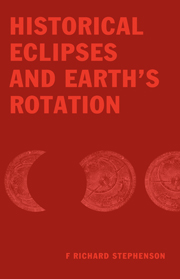Book contents
- Frontmatter
- Contents
- Principal Symbols
- 1 Variations in the length of the day: a historical perspective
- 2 Tidal friction and the ephemerides of the Sun and Moon
- 3 Pre-telescopic eclipse observations and their analysis
- 4 Babylonian and Assyrian records of eclipses
- 5 Investigation of Babylonian observations of solar eclipses
- 6 Timed Babylonian lunar eclipses
- 7 Untimed Babylonian observations of lunar eclipses: horizon phenomena
- 8 Chinese and other East Asian observations of large solar eclipses
- 9 Other East Asian observations of solar and lunar eclipses
- 10 Records of eclipses in ancient European history
- 11 Eclipse records from medieval Europe
- 12 Solar and lunar eclipses recorded in medieval Arab chronicles
- 13 Observations of eclipses by medieval Arab astronomers
- 14 Determination of changes in the length of the day
- Appendix A Timed data
- Appendix B Untimed data
- References
- Acknowledgements
- Index of eclipse records
- Index of places of observation
- Name Index
- Subject index
9 - Other East Asian observations of solar and lunar eclipses
Published online by Cambridge University Press: 13 November 2009
- Frontmatter
- Contents
- Principal Symbols
- 1 Variations in the length of the day: a historical perspective
- 2 Tidal friction and the ephemerides of the Sun and Moon
- 3 Pre-telescopic eclipse observations and their analysis
- 4 Babylonian and Assyrian records of eclipses
- 5 Investigation of Babylonian observations of solar eclipses
- 6 Timed Babylonian lunar eclipses
- 7 Untimed Babylonian observations of lunar eclipses: horizon phenomena
- 8 Chinese and other East Asian observations of large solar eclipses
- 9 Other East Asian observations of solar and lunar eclipses
- 10 Records of eclipses in ancient European history
- 11 Eclipse records from medieval Europe
- 12 Solar and lunar eclipses recorded in medieval Arab chronicles
- 13 Observations of eclipses by medieval Arab astronomers
- 14 Determination of changes in the length of the day
- Appendix A Timed data
- Appendix B Untimed data
- References
- Acknowledgements
- Index of eclipse records
- Index of places of observation
- Name Index
- Subject index
Summary
Introduction
In the previous chapter, East Asian records of total and near-total solar eclipses were analysed. Emphasis was placed on observations which either affirmed or specifically denied that the Sun was completely obscured. Other reported details – such as measurements of the times of the various contacts or rising or setting of the luminary whilst eclipsed – were not considered. The theme of the present chapter is the investigation of further observations of both solar and lunar eclipses from the same part of the world which in principle are of value in the determination of ΔT. These may be grouped in three main categories: (i) timed contacts; (ii) estimates of the proportion of the Sun covered at maximum phase; and (iii) instances where the Sun or Moon was said to rise or set whilst visibly obscured.
In the pre-telescopic period, there is a significant number of Chinese observations in each of the above categories. However, accounts of eclipses from Korea tend to be extremely brief and no useful records are preserved in the history of this country – whether in the Koryo-sa (‘History of Koryo’) or the Choson Wangjo Sillok (‘Veritable Records of the Choson Dynasty’). Although many early Japanese observations of both solar and lunar eclipses give estimates of magnitude or local time, these are contained in a miscellany of sources. Not only is the place of origin often obscure (see also chapter 8), it is frequently difficult to distinguish observation from prediction.
- Type
- Chapter
- Information
- Historical Eclipses and Earth's Rotation , pp. 273 - 333Publisher: Cambridge University PressPrint publication year: 1997



